Evaluation of HY-2B SMR Sea Surface Temperature Products from 2019 to 2024
Abstract
:1. Introduction
2. Materials and Methods
2.1. Datasets
2.1.1. HY-2B SMR SST
2.1.2. iQuam SST
2.1.3. ERA5 SST
2.2. Methods
2.2.1. Collocation and Quality Control
2.2.2. Evaluation Method
- (a)
- Direct comparison
- (b)
- Extended triple collocation
3. Results
3.1. Direct Comparison
3.1.1. SMR SST vs. iQuam SST
3.1.2. ERA5 SST vs. iQuam SST
3.1.3. SMR SST vs. ERA5 SST
3.2. ETC Analysis
3.3. Error Analyses
- (a)
- Temporal variation
- (b)
- Latitudinal variation
- (c)
- Variation related to SST
- (d)
- Variation related to sea surface wind speed
- (e)
- Variation related to columnar water vapor
- (f)
- Variation related to columnar cloud liquid water
4. Discussion
5. Summary
Author Contributions
Funding
Data Availability Statement
Acknowledgments
Conflicts of Interest
References
- D’Agata, S. Ecosystems Services at Risk. Nat. Clim. Chang. 2022, 12, 13–14. [Google Scholar] [CrossRef]
- Chefaoui, R.M.; Martínez, B.D.-C.; Viejo, R.M. Temporal Variability of Sea Surface Temperature Affects Marine Macrophytes Range Retractions as Well as Gradual Warming. Sci. Rep. 2024, 14, 14206. [Google Scholar] [CrossRef] [PubMed]
- Pisano, A.; Marullo, S.; Artale, V.; Falcini, F.; Yang, C.; Leonelli, F.E.; Santoleri, R.; Buongiorno Nardelli, B. New Evidence of Mediterranean Climate Change and Variability from Sea Surface Temperature Observations. Remote Sens. 2020, 12, 132. [Google Scholar] [CrossRef]
- Ateweberhan, M.; McClanahan, T.R. Relationship between Historical Sea-Surface Temperature Variability and Climate Change-Induced Coral Mortality in the Western Indian Ocean. Mar. Pollut. Bull. 2010, 60, 964–970. [Google Scholar] [CrossRef]
- Ruela, R.; Sousa, M.C.; deCastro, M.; Dias, J.M. Global and Regional Evolution of Sea Surface Temperature under Climate Change. Glob. Planet. Chang. 2020, 190, 103190. [Google Scholar] [CrossRef]
- Venegas, R.M.; Acevedo, J.; Treml, E.A. Three Decades of Ocean Warming Impacts on Marine Ecosystems: A Review and Perspective. Deep Sea Res. Part II 2023, 212, 105318. [Google Scholar] [CrossRef]
- O’Carroll, A.G.; Armstrong, E.M.; Beggs, H.M.; Bouali, M.; Casey, K.S.; Corlett, G.K.; Dash, P.; Donlon, C.J.; Gentemann, C.L.; Høyer, J.L.; et al. Observational Needs of Sea Surface Temperature. Front. Mar. Sci. 2019, 6, 420. [Google Scholar] [CrossRef]
- Minnett, P.J.; Alvera-Azcárate, A.; Chin, T.M.; Corlett, G.K.; Gentemann, C.L.; Karagali, I.; Li, X.; Marsouin, A.; Marullo, S.; Maturi, E.; et al. Half a Century of Satellite Remote Sensing of Sea-Surface Temperature. Remote Sens. Environ. 2019, 233, 111366. [Google Scholar] [CrossRef]
- Wentz, F.J.; Gentemann, C.; Smith, D.; Chelton, D. Satellite Measurements of Sea Surface Temperature Through Clouds. Science 2000, 288, 847–850. [Google Scholar] [CrossRef]
- Biswas, S.K.; Gopalan, K.; Jones, W.L.; Bilanow, S. Correction of Time-Varying Radiometric Errors in TRMM Microwave Imager Calibrated Brightness Temperature Products. IEEE Geosci. Remote Sens. Lett. 2010, 7, 851–855. [Google Scholar] [CrossRef]
- Wentz, F.J. A 17-Yr Climate Record of Environmental Parameters Derived from the Tropical Rainfall Measuring Mission (TRMM) Microwave Imager. J. Clim. 2015, 28, 6882–6902. [Google Scholar] [CrossRef]
- Stammer, D.; Wentz, F.; Gentemann, C. Validation of Microwave Sea Surface Temperature Measurements for Climate Purposes. J. Clim. 2003, 16, 73–87. [Google Scholar] [CrossRef]
- Zhao, Y.; Zhu, J.; Lin, M.; Chen, C.; Huang, X.; Wang, H.; Zhang, Y.; Peng, H. Assessment of the Initial Sea Surface Temperature Product of the Scanning Microwave Radiometer Aboard on HY-2 Satellite. Acta Oceanol. Sin. 2014, 33, 109–113. [Google Scholar] [CrossRef]
- Zhang, L.; Yu, H.; Wang, Z.; Yin, X.; Yang, L.; Du, H.; Li, B.; Wang, Y.; Zhou, W. Evaluation of the Initial Sea Surface Temperature From the HY-2B Scanning Microwave Radiometer. IEEE Geosci. Remote Sens. Lett. 2021, 18, 137–141. [Google Scholar] [CrossRef]
- Liu, M.; Guan, L.; Zhao, W.; Chen, G. Evaluation of Sea Surface Temperature From the HY-2 Scanning Microwave Radiometer. IEEE Trans. Geosci. Remote Sens. 2017, 55, 1372–1380. [Google Scholar] [CrossRef]
- Zhao, Y.; Li, H.; Chen, C.; Zhu, J. Verification and Recalibration of HY-2A Microwave Radiometer Brightness Temperature. J. Oceanol. Limnol. 2019, 37, 968–981. [Google Scholar] [CrossRef]
- Wang, Z.; Li, Y.; Yin, X. In-Orbit Calibration Scanning Microwave Radiometer on HY-2 Satellite of China. In Proceedings of the 2014 IEEE Geoscience and Remote Sensing Symposium, Quebec City, QC, Canada, 13–18 July 2014; pp. 1936–1939. [Google Scholar]
- Li, Y.; Li, J.; Hu, T.; Duan, C.; Chen, W.; Lei, W. In-Orbit Correction and Optimization Design of the Calibration Assembly for HY-2 Microwave Radiometer. In Proceedings of the 2014 IEEE Geoscience and Remote Sensing Symposium, Quebec City, QC, Canada, 13–18 July 2014; pp. 5183–5186. [Google Scholar]
- Liu, S.; Jin, X.; Zhou, W.; Wang, X.; Yv, R.; Li, Y.; Dang, H.; Tan, X. Initial Performance of the Haiyang-2b Scanning Microwave Radiometer. In Proceedings of the IGARSS 2019—2019 IEEE International Geoscience and Remote Sensing Symposium, Yokohama, Japan, 28 July–2 August 2019; pp. 8917–8920. [Google Scholar]
- Ma, C.; Zhou, W.; Yin, X.; Yu, R.; Diao, N.; Wang, S. Comparisons between HY-2B SMR and GMI Brightness Temperature from 6 To 37GHz Over the Ocean. In Proceedings of the IGARSS 2019—2019 IEEE International Geoscience and Remote Sensing Symposium, Yokohama, Japan, 28 July–2 August 2019; pp. 8455–8458. [Google Scholar]
- Wang, S.; Zhou, W.; Yin, X.; Li, Y.; Wang, X.; Li, H. Stability of the HY-2B Scanning Microwave Radiometer (SMR) Brightness Temperature Using a Modified Vicarious Cold Reference. IEEE Trans. Geosci. Remote Sens. 2022, 60, 5303916. [Google Scholar] [CrossRef]
- Li, Z.; Han, W.; Xu, H.; Xie, H.; Zou, J. Biases’ Characteristics Assessment of the HY-2B Scanning Microwave Radiometer (SMR)’s Observations. Remote Sens. 2023, 15, 889. [Google Scholar] [CrossRef]
- Zhou, W.; Lin, M.; Yin, X.; Ma, X.; Huang, L.; Wang, S.; Ma, C.; Zhang, Y. Preliminary Estimate of Sea Surface Temperature from the Scanning Microwave Radiometer Onboard Hy-2b Satellite. In Proceedings of the IGARSS 2019—2019 IEEE International Geoscience and Remote Sensing Symposium, Yokohama, Japan, 28 July–2 August 2019; pp. 8173–8176. [Google Scholar]
- Jiang, X.; Yin, X.; Guan, L.; Wang, Z.; Lv, L.; Liu, M. Global Ocean Observations and Applications by China’s Ocean Satellite Constellation. Intell. Mar. Technol. Syst. 2023, 1, 6. [Google Scholar] [CrossRef]
- Gentemann, C.L.; Hilburn, K.A. In Situ Validation of Sea Surface Temperatures from the GCOM-W 1 AMSR 2 RSS Calibrated Brightness Temperatures. J. Geophys. Res. Ocean. 2015, 120, 3567–3585. [Google Scholar] [CrossRef]
- Zhang, H.; Beggs, H.; Griffin, C.; Govekar, P.D. Validation of Himawari-8 Sea Surface Temperature Retrievals Using Infrared SST Autonomous Radiometer Measurements. Remote Sens. 2023, 15, 2841. [Google Scholar] [CrossRef]
- O’Carroll, A.G.; Eyre, J.R.; Saunders, R.W. Three-Way Error Analysis between AATSR, AMSR-E, and In Situ Sea Surface Temperature Observations. J. Atmos. Ocean. Technol. 2008, 25, 1197–1207. [Google Scholar] [CrossRef]
- Kent, E.C.; Kennedy, J.J.; Berry, D.I.; Smith, R.O. Effects of Instrumentation Changes on Sea Surface Temperature Measured in Situ. WIREs Clim. Chang. 2010, 1, 718–728. [Google Scholar] [CrossRef]
- Zhang, H.; Ignatov, A.; Hinshaw, D. Evaluation of the in Situ Sea Surface Temperature Quality Control in the NOAA in Situ SST Quality Monitor (iQuam) System. J. Atmos. Ocean. Technol. 2021, 38, 1249–1263. [Google Scholar] [CrossRef]
- Xu, F.; Ignatov, A. In Situ SST Quality Monitor (iQuam). J. Atmos. Ocean. Technol. 2014, 31, 164–180. [Google Scholar] [CrossRef]
- Xu, F.; Ignatov, A. Error Characterization in iQuam SSTs Using Triple Collocations with Satellite Measurements. Geophys. Res. Lett. 2016, 43, 10826–10834. [Google Scholar] [CrossRef]
- Zhao, Y.; Liu, P.; Zhou, W. Inter-Comparison of SST Products from iQuam, AMSR2/GCOM-W1, and MWRI/FY-3D. Remote Sens. 2024, 16, 2034. [Google Scholar] [CrossRef]
- Minnett, P.J. The Validation of Sea Surface Temperature Retrievals from Spaceborne Infrared Radiometers. In Oceanography from Space; Barale, V., Gower, J.F.R., Alberotanza, L., Eds.; Springer: Dordrecht, The Netherlands, 2010; pp. 229–247. ISBN 978-90-481-8680-8. [Google Scholar]
- Koutantou, K.; Brunner, P.; Vazquez-Cuervo, J. Validation of NASA Sea Surface Temperature Satellite Products Using Saildrone Data. Remote Sens. 2023, 15, 2277. [Google Scholar] [CrossRef]
- Nielsen-Englyst, P.; Høyer, J.L.; Toudal Pedersen, L.; Gentemann, C.L.; Alerskans, E.; Block, T.; Donlon, C. Optimal Estimation of Sea Surface Temperature from AMSR-E. Remote Sens. 2018, 10, 229. [Google Scholar] [CrossRef]
- Gentemann, C.L.; Wentz, F.J.; Mears, C.A.; Smith, D.K. In Situ Validation of Tropical Rainfall Measuring Mission Microwave Sea Surface Temperatures. J. Geophys. Res. Ocean. 2004, 109, C04021. [Google Scholar] [CrossRef]
- Bell, B.; Hersbach, H.; Simmons, A.; Berrisford, P.; Dahlgren, P.; Horányi, A.; Muñoz-Sabater, J.; Nicolas, J.; Radu, R.; Schepers, D.; et al. The ERA5 Global Reanalysis: Preliminary Extension to 1950. Q. J. R. Meteorol. Soc. 2021, 147, 4186–4227. [Google Scholar] [CrossRef]
- Hersbach, H.; Bell, B.; Berrisford, P.; Hirahara, S.; Horányi, A.; Muñoz-Sabater, J.; Nicolas, J.; Peubey, C.; Radu, R.; Schepers, D.; et al. The ERA5 Global Reanalysis. Q. J. R. Meteorol. Soc. 2020, 146, 1999–2049. [Google Scholar] [CrossRef]
- Donlon, C.J.; Martin, M.; Stark, J.; Roberts-Jones, J.; Fiedler, E.; Wimmer, W. The Operational Sea Surface Temperature and Sea Ice Analysis (OSTIA) System. Remote Sens. Environ. 2012, 116, 140–158. [Google Scholar] [CrossRef]
- Fiedler, E.K.; McLaren, A.; Banzon, V.; Brasnett, B.; Ishizaki, S.; Kennedy, J.; Rayner, N.; Roberts-Jones, J.; Corlett, G.; Merchant, C.J.; et al. Intercomparison of Long-Term Sea Surface Temperature Analyses Using the GHRSST Multi-Product Ensemble (GMPE) System. Remote Sens. Environ. 2019, 222, 18–33. [Google Scholar] [CrossRef]
- Good, S.; Fiedler, E.; Mao, C.; Martin, M.J.; Maycock, A.; Reid, R.; Roberts-Jones, J.; Searle, T.; Waters, J.; While, J.; et al. The Current Configuration of the OSTIA System for Operational Production of Foundation Sea Surface Temperature and Ice Concentration Analyses. Remote Sens. 2020, 12, 720. [Google Scholar] [CrossRef]
- Donlon, C.J.; Minnett, P.J.; Gentemann, C.; Nightingale, T.J.; Barton, I.J.; Ward, B.; Murray, M.J. Toward Improved Validation of Satellite Sea Surface Skin Temperature Measurements for Climate Research. J. Clim. 2002, 15, 353–369. [Google Scholar] [CrossRef]
- McColl, K.A.; Vogelzang, J.; Konings, A.G.; Entekhabi, D.; Piles, M.; Stoffelen, A. Extended Triple Collocation: Estimating Errors and Correlation Coefficients with Respect to an Unknown Target. Geophys. Res. Lett. 2014, 41, 6229–6236. [Google Scholar] [CrossRef]
- Yao, L.; Lu, J.; Xia, X.; Jing, W.; Liu, Y. Evaluation of the ERA5 Sea Surface Temperature Around the Pacific and the Atlantic. IEEE Access 2021, 9, 12067–12073. [Google Scholar] [CrossRef]
- Yang, C.; Leonelli, F.E.; Marullo, S.; Artale, V.; Beggs, H.; Nardelli, B.B.; Chin, T.M.; De Toma, V.; Good, S.; Huang, B.; et al. Sea Surface Temperature Intercomparison in the Framework of the Copernicus Climate Change Service (C3S). J. Clim. 2021, 34, 5257–5283. [Google Scholar] [CrossRef]
- Gentemann, C.L.; Meissner, T.; Wentz, F.J. Accuracy of Satellite Sea Surface Temperatures at 7 and 11 GHz. IEEE Trans. Geosci. Remote Sens. 2010, 48, 1009–1018. [Google Scholar] [CrossRef]
- Zhou, W.; Lin, M.; Li, W.; Yin, X.; Li, Y.; Li, X.; Li, Q.; Wang, S.; Yu, R. HY-2B SMR’s Sea Surface Temperature Retrieval Considering Parameter Crosstalk. IEEE Trans. Geosci. Remote Sens. 2023, 61, 4207812. [Google Scholar] [CrossRef]
- Hwang, P.A.; Reul, N.; Meissner, T.; Yueh, S.H. Ocean Surface Foam and Microwave Emission: Dependence on Frequency and Incidence Angle. IEEE Trans. Geosci. Remote Sens. 2019, 57, 8223–8234. [Google Scholar] [CrossRef]
- Wentz, F.J.; Meissner, T. Atmospheric Absorption Model for Dry Air and Water Vapor at Microwave Frequencies below 100 GHz Derived from Spaceborne Radiometer Observations. Radio Sci. 2016, 51, 381–391. [Google Scholar] [CrossRef]
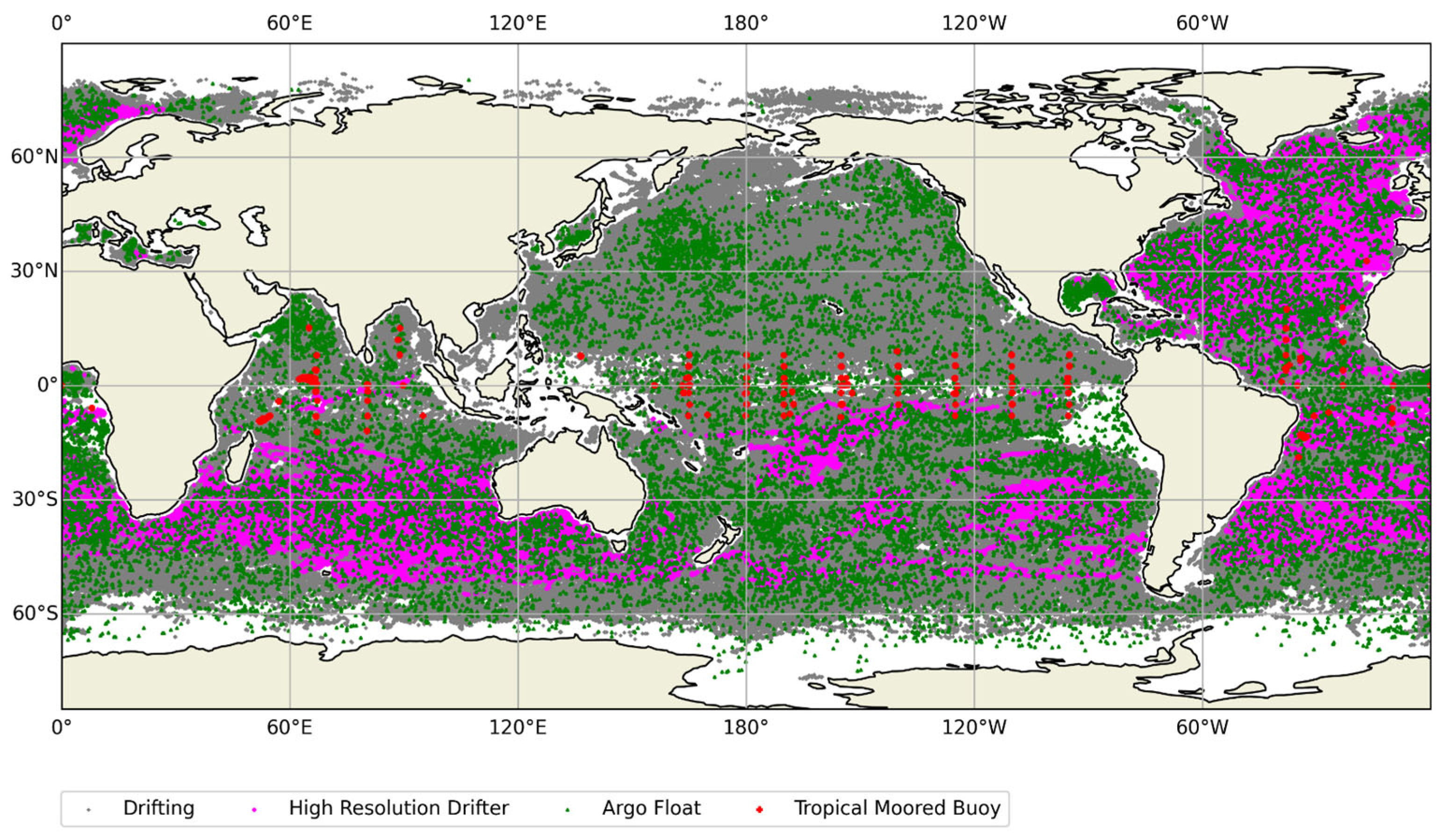

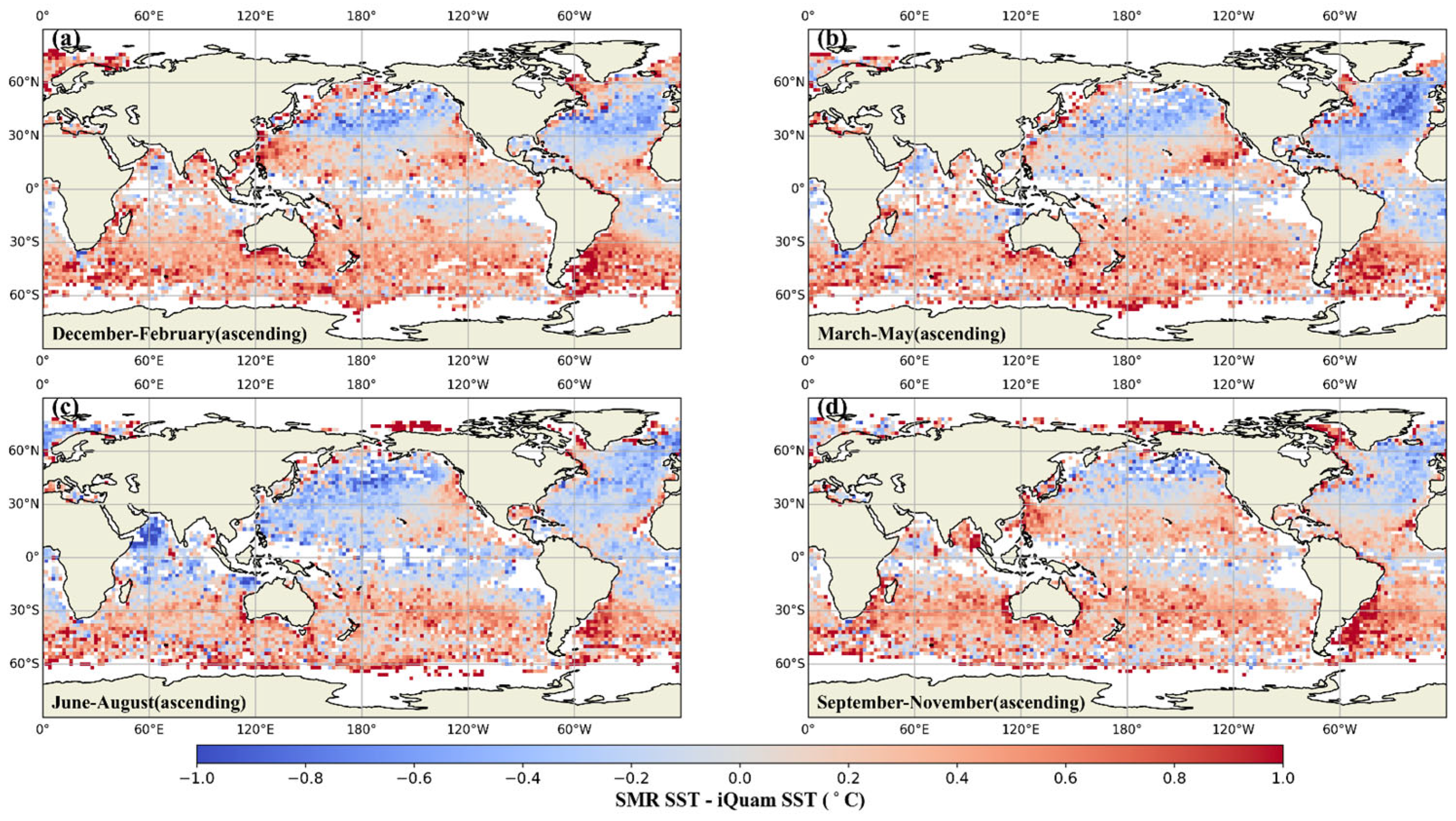
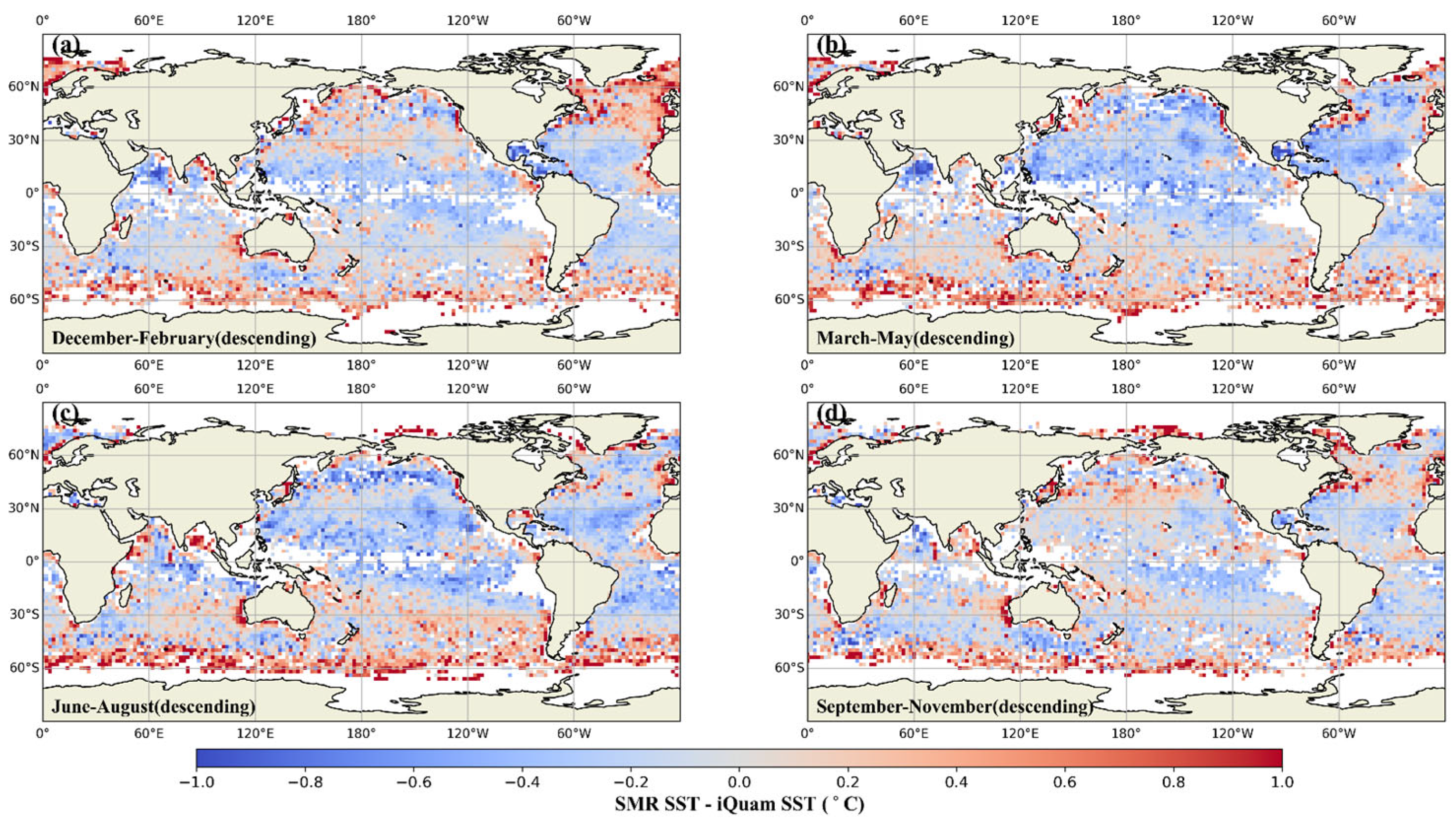
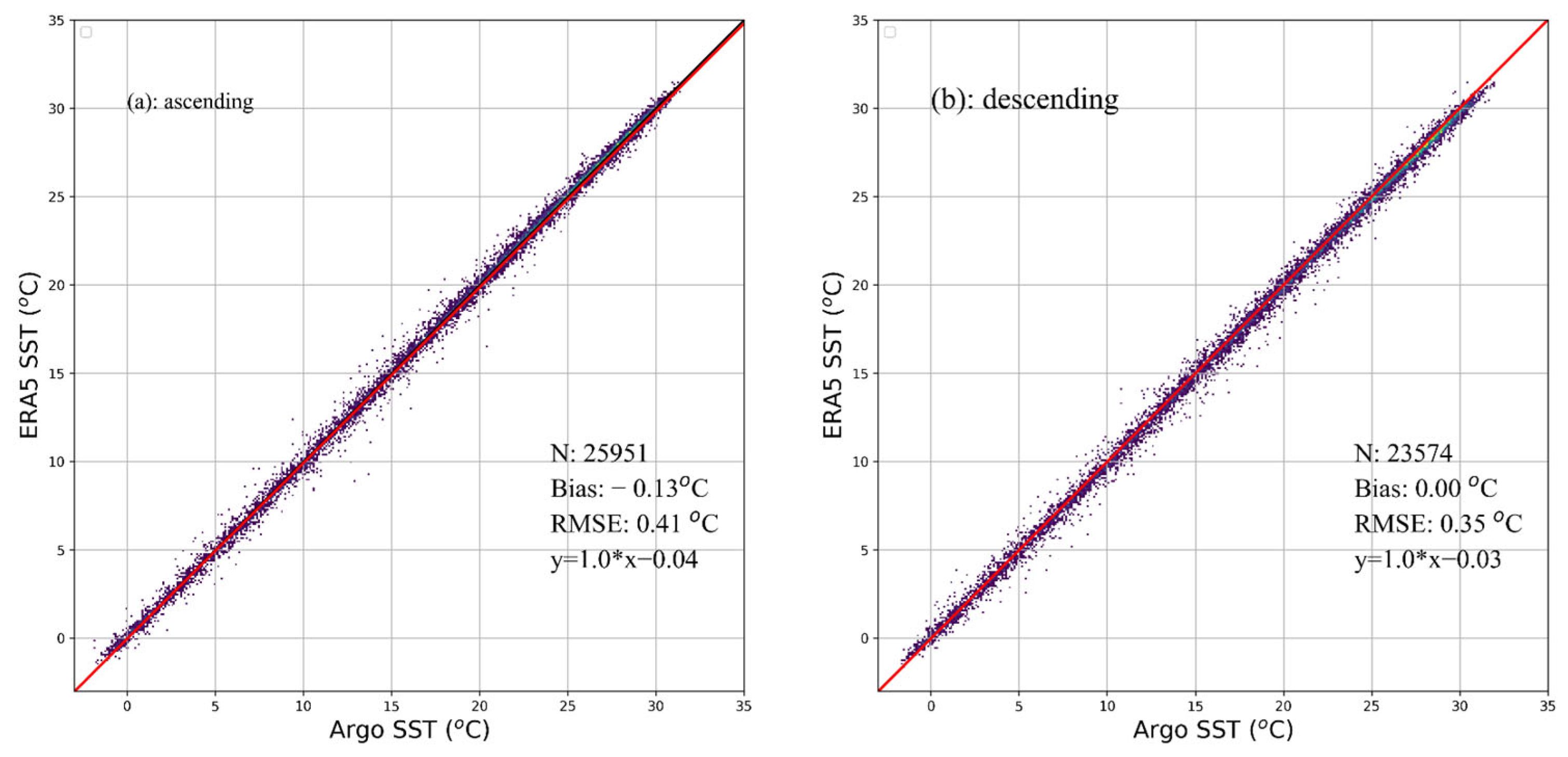
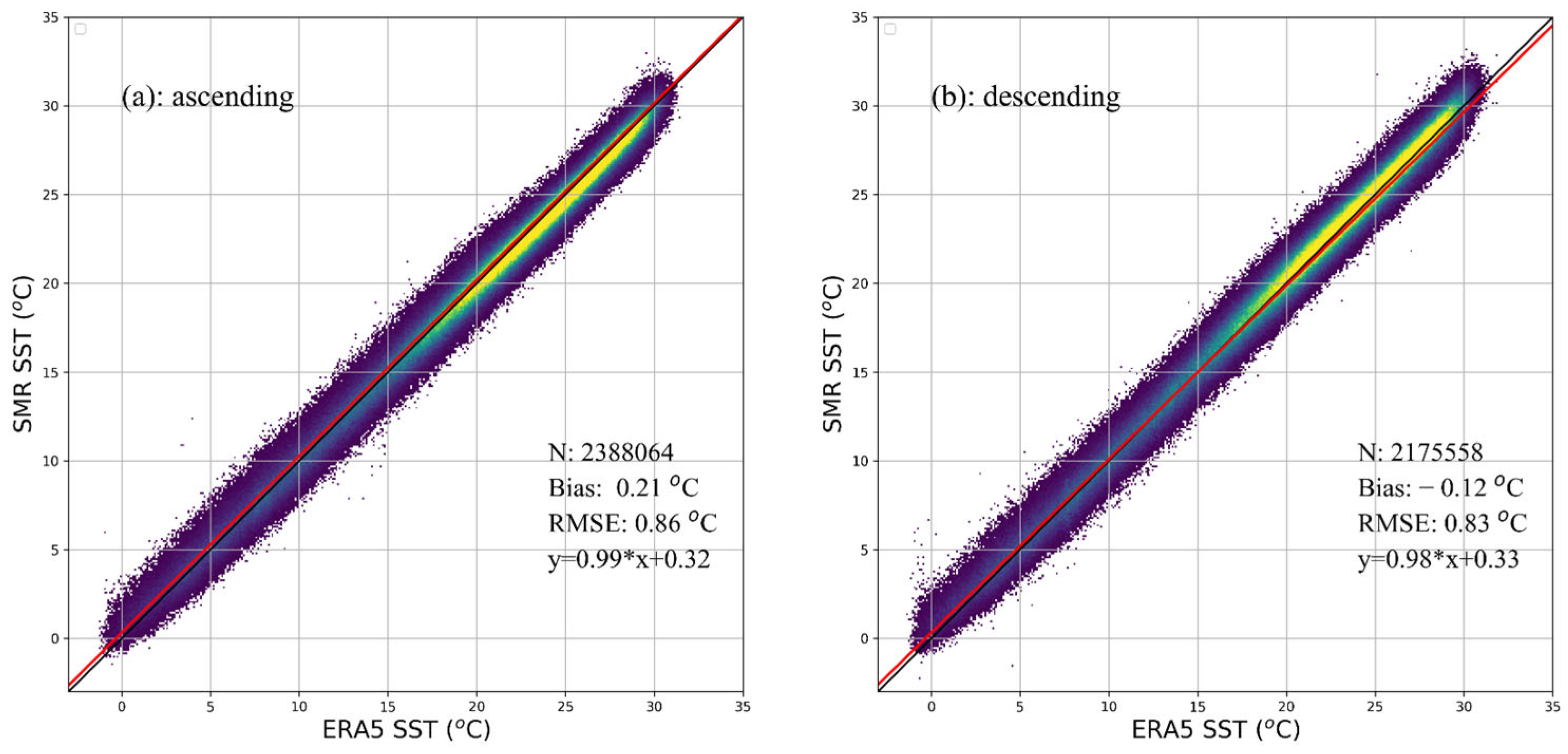
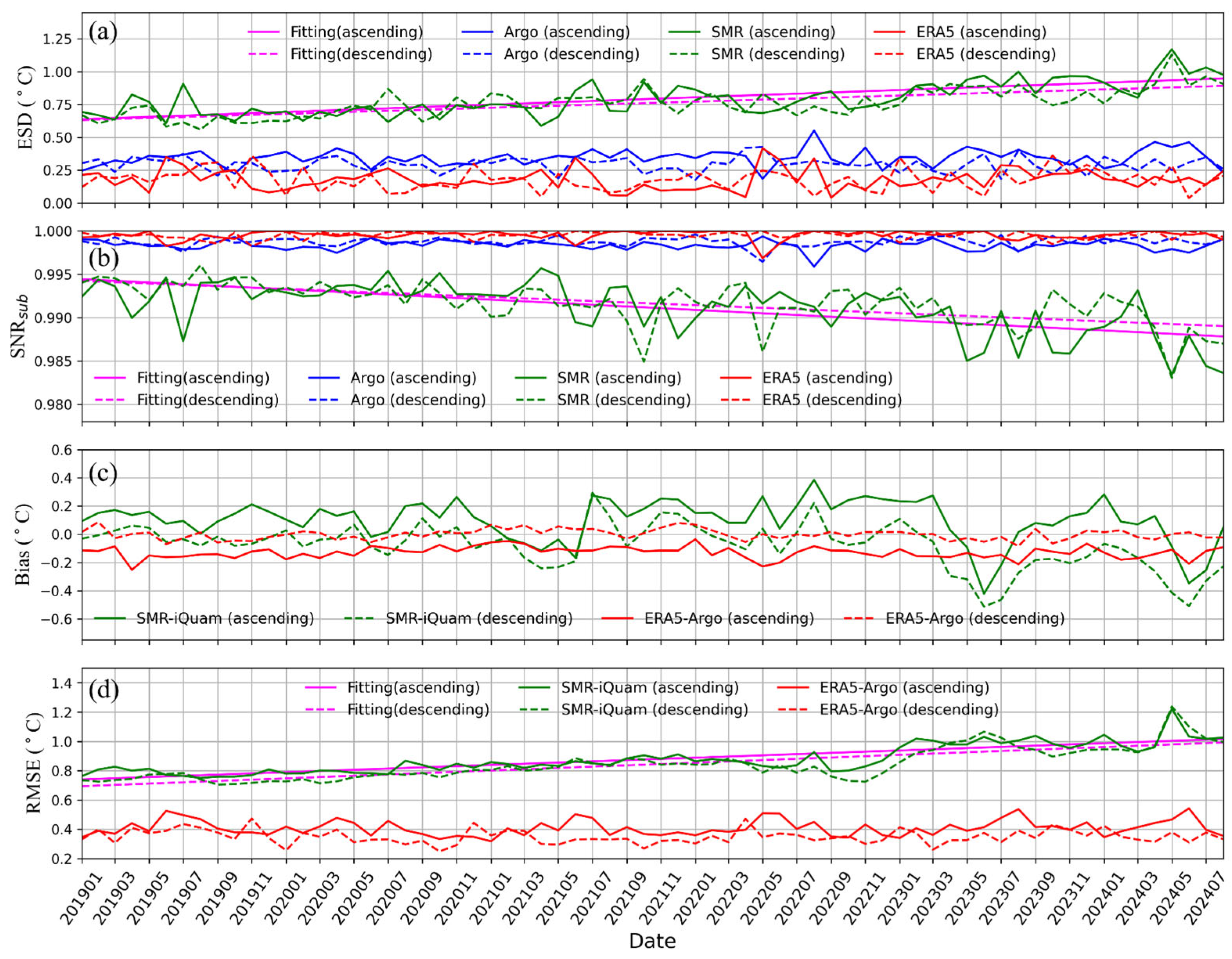
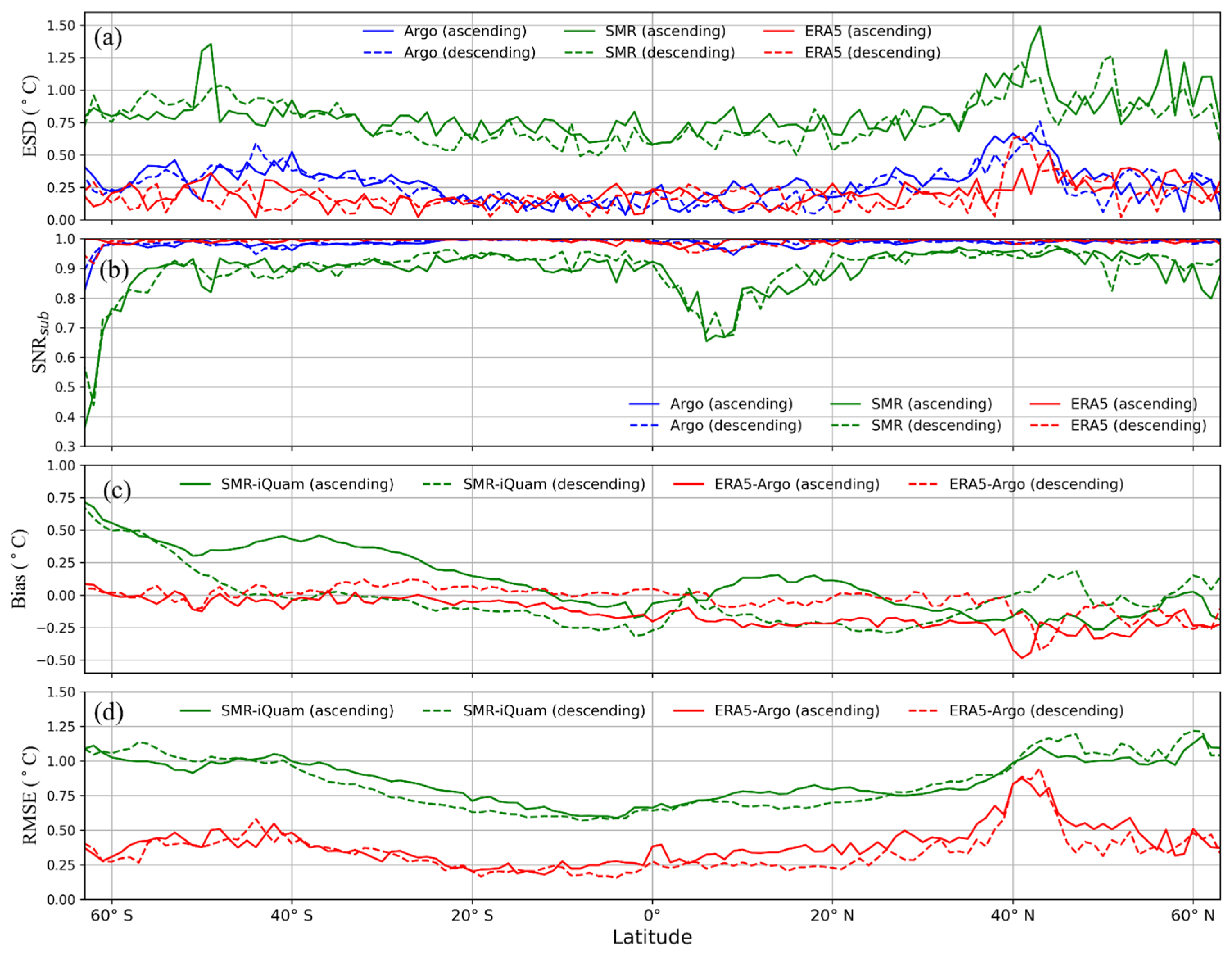

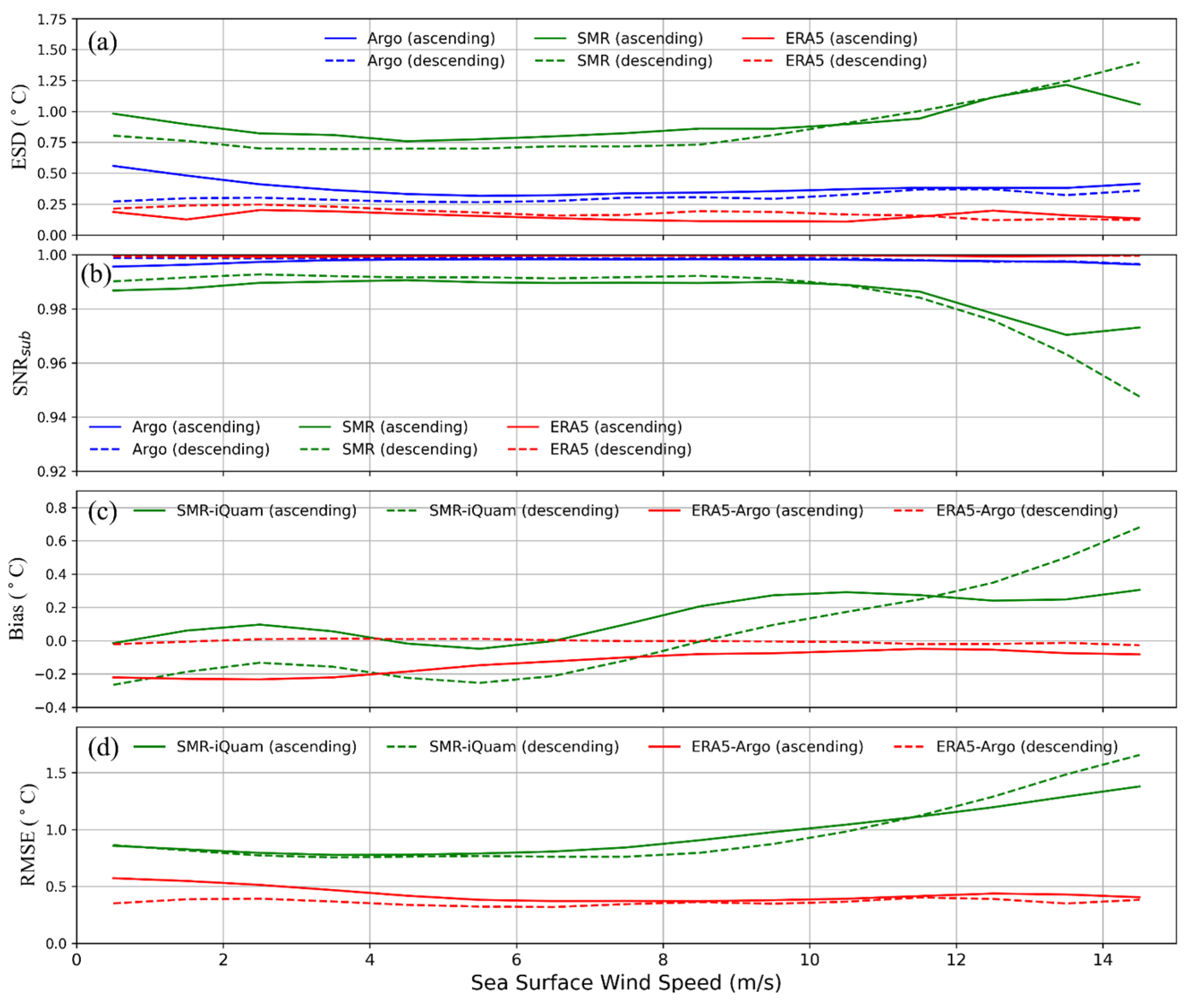

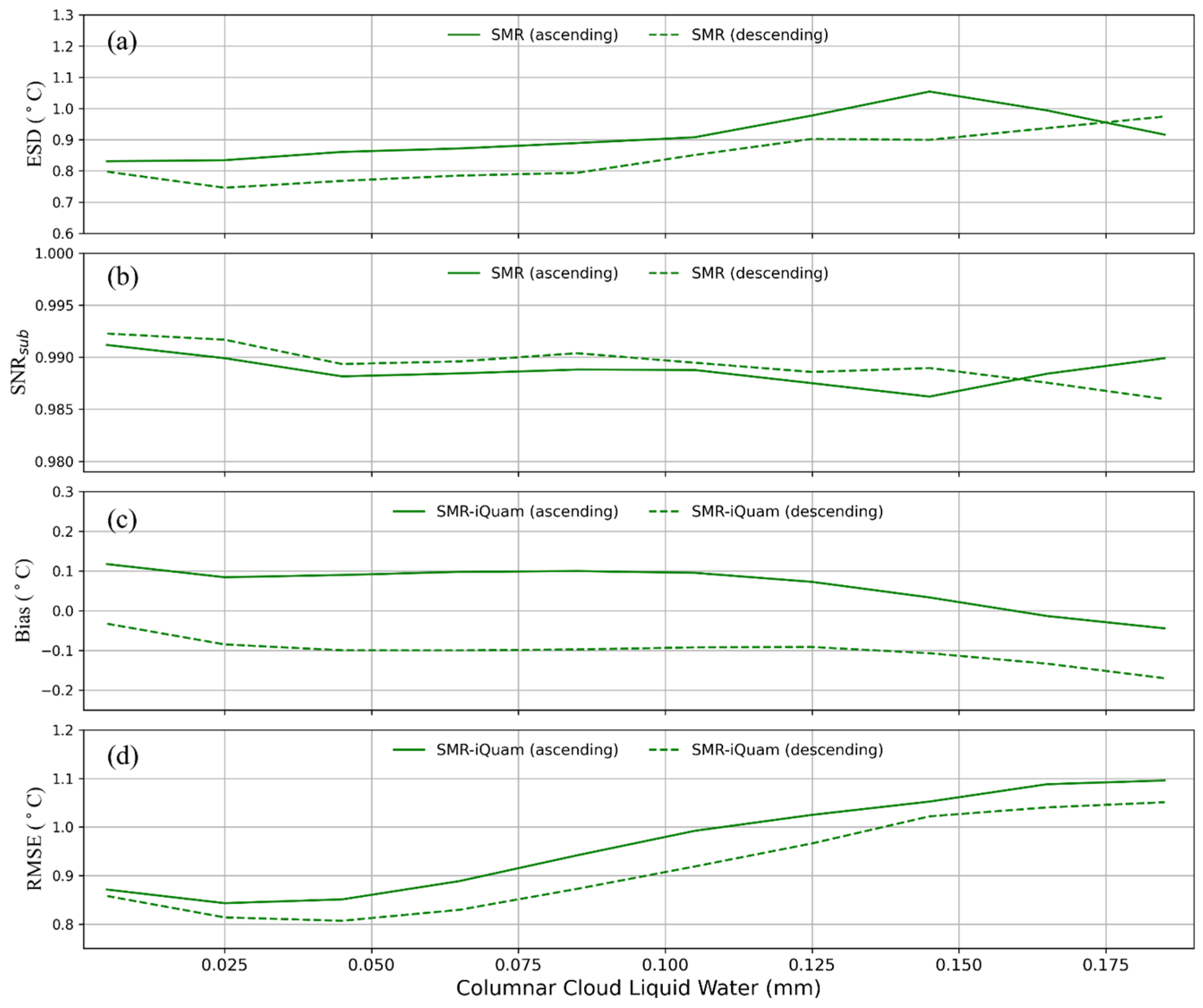
| Frequency (GHz) | Polarization | Band Width (MHz) | IFOV (km) | NE∆T (k) |
|---|---|---|---|---|
| 6.925 | V.H | 350 | 90 × 150 | <0.5 |
| 10.7 | V.H | 100 | 70 × 110 | <0.6 |
| 18.7 | V.H | 200 | 36 × 60 | <0.5 |
| 23.8 | V | 400 | 30 × 52 | <0.5 |
| 37.0 | V.H | 1000 | 20 × 35 | <0.8 |
| Pass | ALL | Drifter | T-M | Argo | HR-D |
|---|---|---|---|---|---|
| Ascending | 2,388,064 | 2,175,903 | 47,692 | 25,951 | 138,518 |
| Descending | 2,175,558 | 1,974,835 | 47,039 | 23,574 | 130,110 |
| Orbit | Errors | All | Drifter | T-M | Argo | HR-D |
|---|---|---|---|---|---|---|
| Ascending | Bias (°C) RMSE (°C) | 0.10 0.88 | 0.11 0.89 | −0.11 0.68 | 0.13 0.95 | 0.04 0.81 |
| Descending | Bias (°C) RMSE (°C) | −0.08 0.85 | −0.07 0.86 | −0.29 0.65 | −0.1 0.89 | −0.07 0.79 |
| Time | Errors | All | Drifter | T-M | Argo | HR-D |
|---|---|---|---|---|---|---|
| Ascending (Sunset) | Bias (°C) RMSE (°C) | −0.11 0.36 | −0.11 0.36 | −0.16 0.28 | −0.13 0.41 | −0.12 0.37 |
| Descending (Sunrise) | Bias (°C) RMSE (°C) | 0.05 0.32 | 0.05 0.32 | 0.04 0.20 | 0.00 0.35 | 0.05 0.33 |
| Data | Parameter | Ascending | Descending |
|---|---|---|---|
| SMR | ESD (°C) | 0.87 0.9900 | 0.80 0.9910 |
| Argo | ESD (°C) | 0.35 0.9984 | 0.30 0.9988 |
| ERA5 | ESD (°C) | 0.16 0.9997 | 0.18 0.9996 |
Disclaimer/Publisher’s Note: The statements, opinions and data contained in all publications are solely those of the individual author(s) and contributor(s) and not of MDPI and/or the editor(s). MDPI and/or the editor(s) disclaim responsibility for any injury to people or property resulting from any ideas, methods, instructions or products referred to in the content. |
© 2025 by the authors. Licensee MDPI, Basel, Switzerland. This article is an open access article distributed under the terms and conditions of the Creative Commons Attribution (CC BY) license (https://creativecommons.org/licenses/by/4.0/).
Share and Cite
Liu, P.; Zhao, Y.; Zhou, W.; Wang, S. Evaluation of HY-2B SMR Sea Surface Temperature Products from 2019 to 2024. Remote Sens. 2025, 17, 300. https://doi.org/10.3390/rs17020300
Liu P, Zhao Y, Zhou W, Wang S. Evaluation of HY-2B SMR Sea Surface Temperature Products from 2019 to 2024. Remote Sensing. 2025; 17(2):300. https://doi.org/10.3390/rs17020300
Chicago/Turabian StyleLiu, Ping, Yili Zhao, Wu Zhou, and Shishuai Wang. 2025. "Evaluation of HY-2B SMR Sea Surface Temperature Products from 2019 to 2024" Remote Sensing 17, no. 2: 300. https://doi.org/10.3390/rs17020300
APA StyleLiu, P., Zhao, Y., Zhou, W., & Wang, S. (2025). Evaluation of HY-2B SMR Sea Surface Temperature Products from 2019 to 2024. Remote Sensing, 17(2), 300. https://doi.org/10.3390/rs17020300







